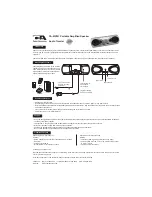
12
│ 4 Maintenance
4.2
Handling faulty lithium ion rechargeable batteries
Lithium ion batteries are always classed as dangerous goods for
transport purposes.
The transportation of faulty lithium ion batteries is only permit-
ted under certain conditions (e.g. must not be transported as air
freight). Where transportation is permitted (e.g. by road or rail),
it is subject to strict regulations. Faulty lithium ion batteries must
therefore always be removed before shipping. Transportation by
road or rail must occur in compliance with the current applicable
version of the ADR
1
regulations.
NOTICE! Risk of damage when opening housing
When opening the housing, components can be damaged me
-
chanically or by electrostatic discharge.
●
The lithium on battery may only be removed if you have legit-
imate grounds to suspect that the battery may be defective.
●
Only SEWERIN Service personnel or an authorized specialist
may replace rechargeable batteries.
4.2.1
Identifying faulty batteries
A lithium ion battery is considered to be faulty if one of the fol-
lowing criteria applies:
2
●
Housing damaged or badly deformed
●
Liquid leaking from battery
●
Smell of gas from battery
● Rise in temperature with the receiver switched off (more than
hand-hot)
●
Plastic parts melted or deformed
●
Connection leads melted
1
French abbreviation for: Accord européen relatif au transport internation-
al des marchandises Dangereuses par Route, *Engl.: European Agree
-
ment concerning the International Carriage of Dangerous Goods by
Road
2
According to: EPTA – European Power Tool Association








































